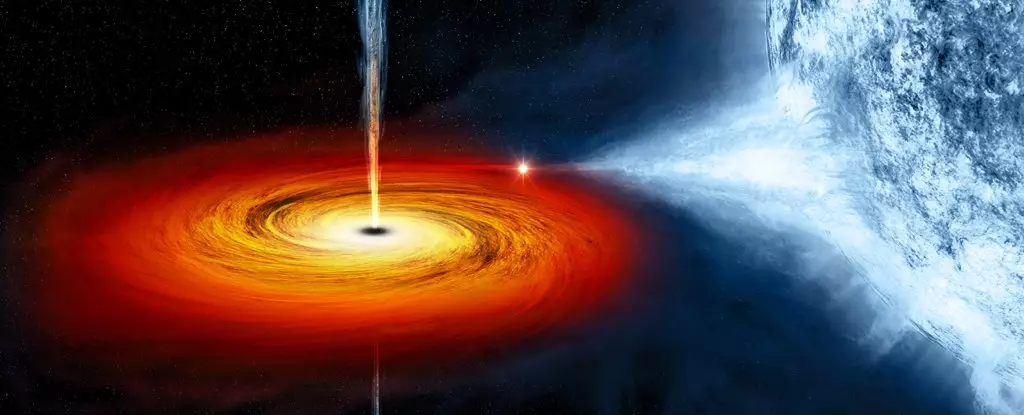For decades, astrophysicists have gazed into the depths of space, pondering the origins of the universe’s highest-energy gamma rays. Traditionally, these enigmatic photons have been attributed to supermassive black holes lurking in the cores of distant quasars. However, recent groundbreaking research has shifted the narrative, revealing that some of the most potent gamma rays originate from a relatively nearby cosmic entity: the microquasar V4641 Sagittarii. This newfound source challenges long-held beliefs regarding where and how such high-energy photons are produced in the universe.
Situated approximately 20,000 light-years away in the constellation Sagittarius, V4641 Sagittarii comprises a black hole with a mass approximating six times that of our Sun, in the process of devouring material from a companion star of roughly three solar masses. This stellar interaction is akin to a cosmic particle accelerator, generating gamma rays with energy levels reaching an astonishing 200 teraelectronvolts (TeV). To put this into perspective, this energy output is 200 trillion times that of visible light, positioning it among the highest-energy photons detected across the cosmos.
Historically, physicists believed microquasars like V4641 Sagittarii would emit gamma rays at energy levels significantly lower than those produced by larger quasars. Physicist Sabrina Casanova aptly notes that previous observations showcased microquasars emitting in the range of tens of gigaelectronvolts. The staggering new findings, however, present a striking contradiction to this paradigm, demonstrating that V4641 Sagittarii emits gamma rays at unprecedented energy levels.
The groundbreaking observation of V4641 Sagittarii’s gamma rays stemmed from sophisticated instrumentation at the High-Altitude Water Cherenkov Observatory (HAWC) in Mexico. Located on the slopes of the extinct Sierra Negra volcano, HAWC is outfitted with 300 large steel tanks filled with purified water. This state-of-the-art facility is meticulously designed to detect high-energy cosmic particles as they stream toward Earth.
When charged particles enter the water tanks, they generate a cascade of secondary particles that surpass the speed of light in water, leading to the emission of a phenomenon known as Cherenkov radiation. This flash of light resembles a sonic boom in its electromagnetic form. HAWC’s sensitive detectors capture these flashes and enable scientists to backtrack the origins and nature of the incident particles, constructing a vast cosmic map that includes data from 15 percent of the sky at any given moment.
In a serendipitous discovery, physicist Xiaojie Wang identified V4641 Sagittarii as an unexpectedly bright source of gamma rays while sifting through HAWC’s comprehensive sky map. The apparent brightness, located five degrees off the galactic plane, marked it as an anomaly, leading to a detailed examination that ultimately confirmed its status as a source of ultra-high-energy gamma radiation.
The revelation that V4641 Sagittarii emits gamma rays comparable to those from massive quasars significantly alters our understanding of cosmic radiation sources. Not only does this find reframe the capacities of microquasars, but it also provides valuable insights into the general mechanisms of high-energy radiation in the universe. The dynamics of matter interaction between the black hole and its companion star happens over a much shorter timescale than in larger quasars, offering astronomers a faster, more dynamic laboratory for understanding how these phenomena unfold.
These microquasars can serve as natural cosmic simulators. As they model processes akin to those occurring in supermassive black holes but on a more manageable scale, researchers can observe rapid reactions that would otherwise take millions of years to manifest in larger counterparts. This newfound ability to study such cosmic events can yield deeper insights into the foundations of astrophysics and the functioning of the universe itself.
The identification of V4641 Sagittarii as a source of ultra-high-energy gamma rays presents a significant leap in our comprehension of cosmic radiation and black hole activity. As scientists glean more data from observatories like HAWC, they are likely to uncover additional revelations that reshape our understanding of the universe. This groundbreaking discovery is a testament to the value of exploration in astrophysics, unveiling a portrait of a cosmos teeming with untapped mysteries and challenges to our knowledge. As we advance into this new era of cosmic exploration, one can only wonder what further surprises lie in wait among the stars.


Leave a Reply